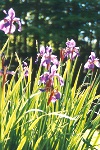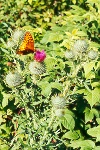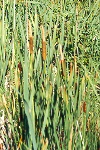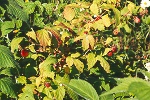|
Back to Flowers and Small Plants Common Dandelion to Downy Yellow Violet Evening Primrose to Meadowsweet Northern Pitcher Plant to Queen Anne's Lace Trout Lily to Yellow Pond Lily |
Berries - Raspberries and blueberries are two types of berries which grow in the valley. Blueberries are the most common berries in the area, with tiny, round berries growing on low-lying shrubs. Raspberries are deep red berries which grow on tall, prickly stems in large bunches. Both of these berries provide meals for everyone from the bears to the bees and people.
Black-eyed Susan - This daisy-like flower has gold-yellow petals surrounding a rich brown centre and topping lush green stems. This unique plant grows 1 to 3 feet high, and flowers in meadows, fields and open woods from June to October. This flower is possibly an escaped species, but is now so common that it is considered native to the area.  Blue Flag - This deep-indigo, bell-shaped blossom - a member of the Iris family - grows on a thick stalk 2 to 3 feet tall. It blooms in May to August, growing best in wet soil and swamps.  Bull Thistle - Many large, pinkish-purple flowers bloom on a tall stem, which can grow 2 to 6 feet high and should not be handled with bare hands. Its preferred habitats are on roadsides, in meadows and in dump areas.  Cattails - These marsh plants have a nutritious content like that of rice and corn, but are eaten only by birds. In June or July their tops are a rich, chocolate-brown, but in Autumn the seeds appear and turn the heads into white bunches of fluff. Many birds nest in cattails, including red-winged blackbirds.  Chicory - Chicory, which has several pale blue blossoms on a tall stalk, flowers throughout June to October in meadows, roadsides and dump areas. Only a few blossoms open up at once, and each only for a day. Although some people think of chicory as a useless weed, its roots can be used as a substitute for coffee grounds.  |
Home | Natural Environment | History | Industry | Personalities/Stories| Credits/Team

